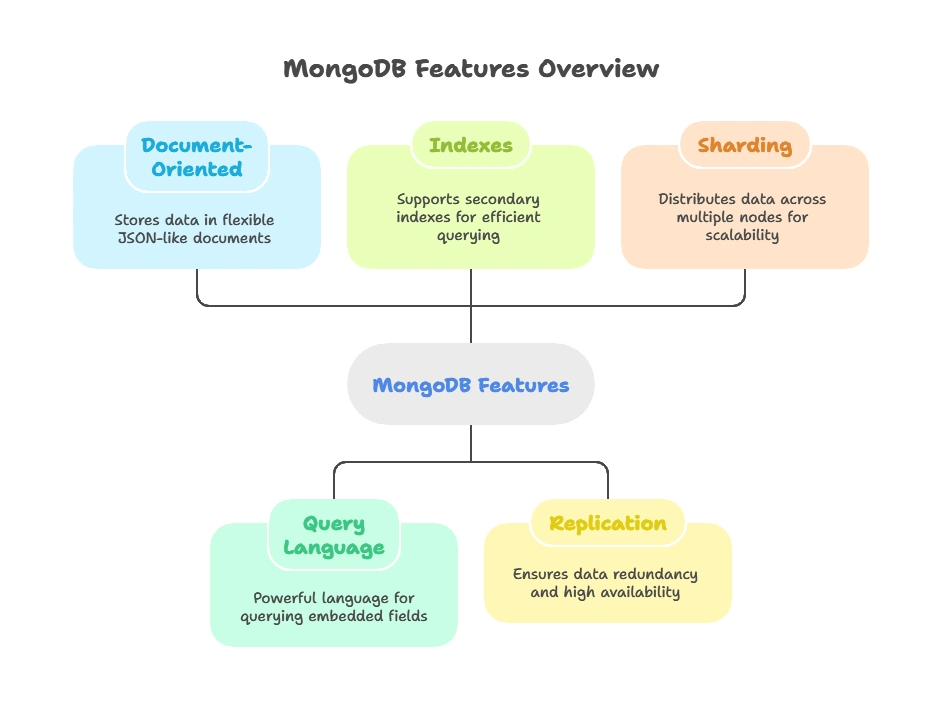What is MongoDB ?
MongoDB falls under the category of NoSQL (Not only SQL) databases, which diverge from traditional relational databases by offering a more flexible data model. Unlike relational databases that use tables and rows, MongoDB stores data in JSON-like documents with dynamic schemas, known as BSON (Binary JSON).
Origin and History
Origin: MongoDB was conceived in 2007 by Dwight Merriman, Eliot Horowitz, and Kevin Ryan, who founded 10gen (now MongoDB Inc.) to develop the database. It aimed to address the scalability and flexibility challenges of relational databases in web applications handling diverse and rapidly changing data.
History: The first stable release, MongoDB 1.0, debuted in February 2010. Initially embraced by startups and web developers for its ease of use and scalability, MongoDB gained traction in enterprises seeking agile solutions for handling complex, unstructured data.
Features
Document-Oriented: MongoDB stores data in collections of JSON-like documents, where each document can have a different structure. This schema flexibility allows developers to store and manage data in a way that mirrors the application’s objects and data models.
Query Language: MongoDB uses a powerful query language similar to SQL but tailored for document databases. It supports queries that can match on embedded fields, perform range queries, and use regular expressions for pattern matching.
Indexes: MongoDB supports secondary indexes on any field within a document, allowing for efficient querying and improved performance. Indexes can include keys from embedded documents and arrays.
Replication: MongoDB uses replica sets for data redundancy and high availability. A replica set consists of multiple nodes, where one node serves as the primary and others act as secondaries. Automatic failover ensures continuity in case of primary node failure.
Sharding: To handle large datasets and high throughput, MongoDB employs sharding, distributing data across multiple nodes (shards). Each shard is responsible for a subset of the data, enabling horizontal scaling without sacrificing performance.

Advantages
Flexible Schema Design: MongoDB’s schemaless design accommodates changes in data structure without requiring downtime or complex migrations. This flexibility is particularly advantageous in agile development environments where requirements evolve rapidly.
Horizontal Scalability: By distributing data across shards, MongoDB scales horizontally to handle increasing data volumes and read/write operations. This capability makes it suitable for applications with unpredictable growth patterns.
Performance: MongoDB’s architecture and storage format optimize read and write operations, delivering high performance for applications requiring real-time data access and low-latency queries.
Document Model: Storing data in documents allows MongoDB to efficiently retrieve and manipulate hierarchical data structures, nested arrays, and key-value pairs within a single entity. This document-oriented approach minimizes the need for complex joins common in relational databases.
Drawbacks
Complexity in Schema Design: While schema flexibility is a strength, it can lead to challenges in managing data consistency and application logic, especially in environments with rapidly changing requirements.
Memory Consumption: MongoDB’s in-memory operations and index storage can consume significant server memory, requiring careful capacity planning and optimization for large-scale deployments.
Transaction Support: Historically, MongoDB lacked full support for multi-document transactions across replica sets. Although recent versions have introduced transactions, they may not yet meet the strict ACID (Atomicity, Consistency, Isolation, Durability) guarantees required by all applications.
MongoDB continues to evolve with each release, addressing user feedback and expanding its capabilities to cater to diverse use cases across industries. Its combination of flexibility, scalability, and performance makes it a preferred choice for modern application development, especially in environments with complex data requirements and high-performance demands.Happy coding !❤️
